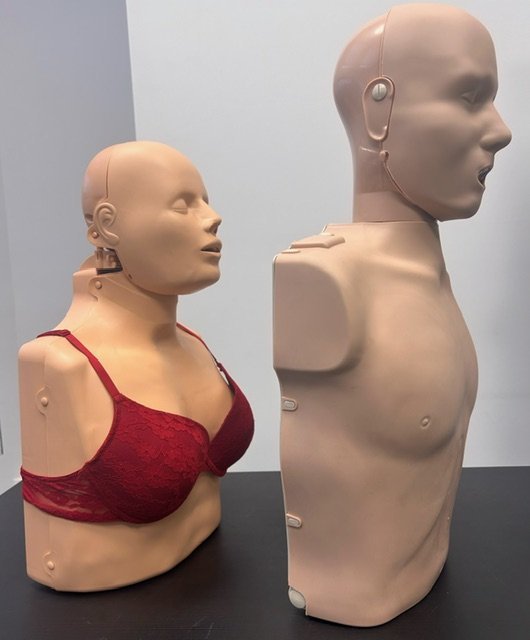Belgian Red Cross-Flanders - Brussels Capital introduces first training mannequin with female anatomy for first aid courses

Belgian Red Cross-Flanders Brussels capital today introduces its first training manikin with female anatomy for its free First Aid courses. Studies have already unequivocally shown that survival rates almost double when bystanders apply CPR techniques to victims in heart failure. Those victims include both men and women. Yet during First Aid training, only male CPR manikins are typically used.
Although there is no consensus in the scientific literature on this subject (yet), there is a risk that women would be less likely to be resuscitated by bystanders than men. Thus, to remove potential barriers, it may make sense to practice with a female manikin during training. Indeed, the core idea of First Aid training is that effective first aid provision begins with an understanding of the importance of first aid, the development of first aid competencies, and the willingness and necessary self-confidence to provide first aid regardless of the patient's gender. When providing first aid to women, social norms related to inappropriate behavior, misconceptions about heart attacks in women or women's lack of familiarity with CPR could hinder willingness and confidence. The use of realistic female training manikins during CPR training could remove some of this reluctance.
The Brussels branch of Belgian Red Cross-Flanders has therefore taken the initiative to purchase a training manikin with female anatomy and include it in first aid training . Not only does this offer the possibility of collecting more data, but it can also reinforce the existing literature with insights from the analysis of the "Brussels" data. The purchase of the training manikin was made possible thanks to project grants from Polsslag Brussels.
Professor Dirk Devroey, dean of the Faculty of Medicine and Pharmacy at the VUB, says: "It is important that care should address the specificities of both sexes and I welcome the initiative of the Brussels department of Belgian Red Cross-Flanders. For example, it can help teach people where to place their hands for chest compressions in women, which can make a crucial difference between life and death. With a female CPR manikin, they can be taught this without hesitation."
Laurette Steenssens, community chairwoman of Belgian Red Cross-Flanders, comments, "We think this step can be very important toward more effective first aid. We give this initiative every chance. Our sincere thanks to the Flemish minister responsible for Brussels for his support of the Brussels operation of Belgian Red Cross-Flanders."
Flemish Minister of Brussels, Benjamin Dalle: "I am particularly pleased that Belgian Red Cross-Flanders Brussels capital will include female training dolls. Women are more than 'little men'. Everyone in mortal danger should have the highest chance of successful resuscitation. Gender should not play a role in this and correct anatomical knowledge is therefore necessary. Better trained first aid students means higher chances of survival for everyone."
Bert Van Driessche, manager Belgian Red Cross-Flanders Brussels Capital, adds: "From now on, our trainees can practice on both puppets, giving them a wider range of experiences. In this way, we also hope to attract even more people to come and take our courses. Belgian Red Cross-Flanders Brussels-Capital currently offers a wide range of free first aid courses in Dutch, organized in the city center. Last year, nearly 500 trainees were trained."
